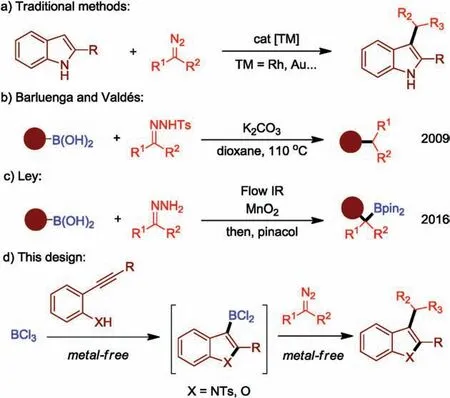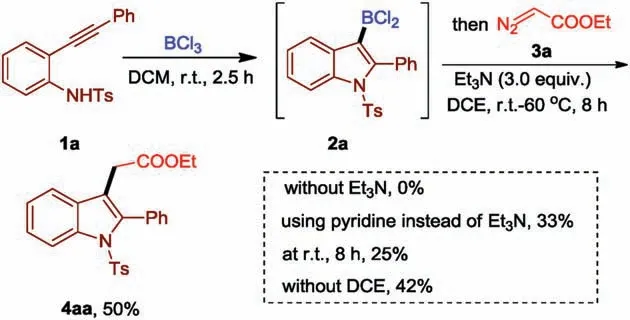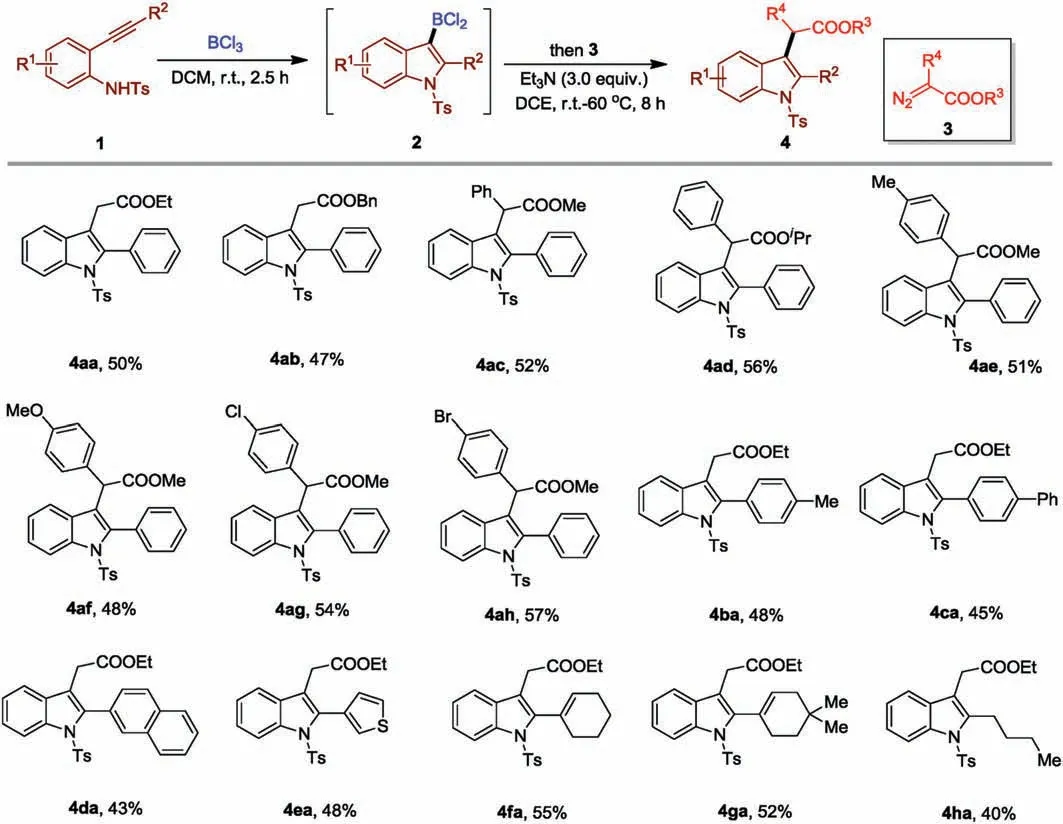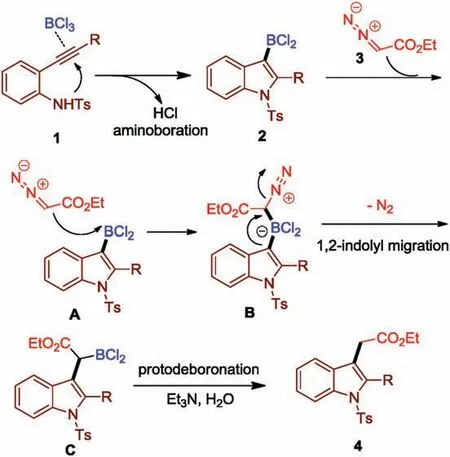Metal-free cascade boron–heteroatom addition and alkylation with diazo compounds
2021-05-14JihngLvBinlinZhoYingHnYuYunZhungzhiShib
Jihng Lv,Binlin Zho,Ying Hn*,Yu YunZhungzhi Shib,*
a College of Chemistry and Chemical Engineering, Yangzhou University, Yangzhou 225002, China
b State Key Laboratory of Coordination Chemistry, School of Chemistry and Chemical Engineering, Nanjing University, Nanjing 210093, China
c Department of Chemistry and Materials Science, College of Science, Nanjing Forestry University, Nanjing 210037, China
ABSTRACT Transition metal-catalyzed carbene transfer reaction is one of the most notable advances for Cbond formation reactionsduring the past decade, which has been widely employed in the preparation of C3-substituted indoles.Here,we described an efficient example of catalyst-and metal-free aminoboration of alkynes and Cbond formation with diazo compounds to produce C3-substituted indoles.Diverse alkynylanilines and diazo compounds can be utilized for this tandem transformation under mild reaction conditions,resulting in broad functional group compatibility.Additionally,this metal-free strategy can be extended to construct substituted benzofurans.
Keywords:Indoles Aminoboration Metal-free BCl3Diazo compounds
The indole unit exists ubiquitously in biologically active molecules, natural products, pharmaceuticals, and agrochemicals[1].Therefore,the development of new methods for the synthesis of functionalized indole derivatives has been a topic of great importance [2].C3-Substituted indoles are the core structure of various drugs and medicinally important agents [3], transitionmetal-catalyzed functionalization of indoles by carbene transfer provides an attractive route to produce these compounds(Fig.1a).Many groups have achieved thefunctionalization of indoles with diazo compounds to buildbonds at C3-position[4].More recently, other transition-metals like Au [5], Pd [6], Cu [7], Fe [8]and Mb [9] have also been employed to enable these transformations.Due to economic and toxicity concerns of transitionmetals,there is a significant interest in the development of metalfree variant to mimic such conversions.

Fig.1.Reaction design.

Scheme 1.Reaction development.
We initiated our study by investigating the cyclization of oalkynylaniline 1a with BCl3(Scheme 1).As a result,we discovered that the use of 1.0 equiv.of 1a with 2.0 equiv.of BCl3in DCM at room temperature for 2.5 h led to the full conversion of the precursors and formation of boron complex 2a.Then, the solvent was removed in vacuo and diazo compound 3a(3.0 equiv.)and dry Et3N(3.0 equiv.)in dry DCE was added slowly to the above system under argon atmosphere.The solution was then slowly warmed to room temperature and continued to stirr for another 2 h.Subsequently the temperature increased to 60slowly,and then stirred for another 6 h.The desired indole product 4aa was isolated with 50% yield in this cascade reaction.When the reaction was carried out without the base, we did not observe any alkylation product.Other bases such as pyridine were also efficient for this reaction, but with much lower reactivity.Lowering the reaction temperature to room temperature led to form product 4aa in 25%yield.In addition,the use of DCM for the second step reaction was found slightly inferior than that of DCE.

Scheme 2.Metal-free cyclization and subsequent bond formation.Reaction conditions:1(0.20 mmol),BCl3(0.4 mL,1.0 mol/L in DCM),in DCM(1.0 mL),2.5 h,r.t.,under Ar; then diazo compound 3 (0.60 mmol), dry Et3N (0.60 mmol), in dry DCE (1 mL), r.t.to 60, 8 h, under Ar.

Scheme 3.Cascade oxoboration and reaction with ethyl diazoacetate.
With the optimized reaction conditions in hand, we first investigated the scope of diazo compounds 3 with o-alkynylaniline 1a(Scheme 2).Diazoacetate 2a bearing a COOBn substituent also underwent facile cyclization and alkylation to generate the corresponding product 4ab in 47% yield.Diazo-phenylacetates containing COOMe (3c) and COOiPr (3d) worked well under the reaction conditions,affording the corresponding products 4ac and 4ad in 52% and 56% yields.Other diazo-arylacetates including methyl (3e), methoxy (3f), Cl (3g), and Br (3h) groups at aryl motifwere compatible under the reaction conditions (4ae-4ah).Next,we turned our attention toexplore the sequentialbond formation using different alkynylanilines with diazo compound 3a.Aromatic groups with diverse substitution patterns like 4ba and 4ca could be transferred effectively from the corresponding oalkynyl groups.The naphthalene and thiophene-containing products 4da-4ea were also formed in 43%–48% yields.It was noteworthy that ortho-enynyl substituted amines including 1f and 1g were tolerable with the reaction system, and the products 4fa and 4ga were isolated in 55% and 52% yields.In addition, the developed system was also tolerant of alkyl substituent, and the compound 4 ha was produced in a 40% yield.
A major benefit of this metal-free and cascade strategy is that other substituted heteroaromatic compounds could also be formed.For example,C3-substituted benzofurans 7 and 8 resulted from BCl3-induced annulation oxoborationandcoupling with diazo compounds could be produced in 43% and 48% yields,respectively (Scheme 3) [15].
Finally, we proposed a mechanism of this tandem process in Fig.2.Based on the previously reported results[13],the reaction of alkynylanilines 1 and BCl3can form dichloro(indolyl)borane 2 first.Once it formed, the nucleophilic diazo carbon can attract to the BCl2group via intermediate A to form boron species B.The 1,2-indolyl migration occurs to produce another borane species C.According to reported work[11],compound C can further convert into product 4a by protodeboronation in the presence of base and water.

Fig.2.Proposed mechanism.
In summary, we have put forward an efficient BCl3-mediated strategy for the cascade cyclization of varieties of o-alkynylanilines andcoupling with diazo compounds under metal-free conditions.Although the modest total yields were provided for this two-step cascade transformation, the use of this method for the preparation of substituted indoles under mild conditions avoiding the use of transition metals would still be of great importance.
Declaration of competing interest
The authors declare that they have no known competing financial interests or personal relationships that could have appeared to influence the work reported in this paper.
Acknowledgments
This study was supported by the National Natural Science Foundation of China(Nos.21972064 and 21672097),the Excellent Youth Foundation of Jiangsu Scientific Committee (No.BK20180007), and the “Innovation & Entrepreneurship Talents Plan” of Jiangsu Province.
Appendix A.Supplementary data
Supplementarymaterialrelatedtothisarticlecanbefound,inthe online version,at doi:https://doi.org/10.1016/j.cclet.2020.06.028.
杂志排行
Chinese Chemical Letters的其它文章
- Quantitative assessment of rhodamine spectra
- One-step straightf oward solid synthesis of high yield white fluorescent carbon dots for white light emitting diodes
- Free-standing nitrogen doped graphene/Co(OH)2composite films with superior catalytic activity for aprotic lithium-oxygen batteries
- Amorphous silicon from low-temperature reduction of silica in the molten salts and its lithium-storage performance
- Two 2D uranyl coordination complexes showing effective photocatalytic degradation of Rhodamine B and mechanism study
- Recent advances in electrochemical sensors for antibiotics and their applications
